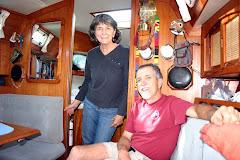We awoke to find ourselves anchored outside the bay at Hana Moe Noa, where we had enjoyed a beautiful stay the week before. From our new, much higher vantage point, we could see a school of large dorado swimming around near the stern of the ship.
This was another island that we had already seen. But as at earlier stops, we found we were presented with much better opportunities to interact with locals and see interesting sights. After a quick stop at Vaitahu, where some passengers went to church and a few others got tattooed(!),

I elected to walk the road to the next village instead of re-boarding the Aranui for the 3-mile voyage. David, a retired airman from Scotland, accompanied me, while Vicki did a little shopping!
Hapatoni turned out to be a really delightful stop because of the friendly locals. David and I, arriving early, helped hand out palm “crowns” to the rest of the Aranui passengers.




The villagers served us a delicious lunch made with local seafood and fruits, after which we had plenty of time to walk around to look at old paepae (stone platforms for traditional houses) and the not so old church.


Once we were all back on the boat, the anchor was raised and the Aranui headed out to sea. I confidently explained to Vicki how we were now heading to the northern Marquesas, a different group of islands about 70 miles away. However, about ten miles out to sea, the Aranui started turning to port, and soon we had gone full circle, returned to the coast of Tahuata, and dropped the anchor at Hana Moe Noa again! Turned out that this had been merely a chance for the Aranui crew to fish off the stern, during their Sunday afternoon off. We would steam to our next stop during the night, after everyone was asleep.






























